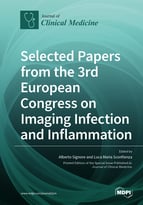Selected Papers from the 3rd European Congress on Imaging Infection and Inflammation
A special issue of Journal of Clinical Medicine (ISSN 2077-0383). This special issue belongs to the section "Nuclear Medicine & Radiology".
Deadline for manuscript submissions: closed (31 May 2020) | Viewed by 41841
Special Issue Editors
Interests: nuclear medicine; infection imaging; inflammation imaging; thyroid cancer imaging; pre-clinical imaging; imaging immuno-therapy; imaging autoimmune diseases
Special Issues, Collections and Topics in MDPI journals
Interests: imaging; ultrasonography; diagnostic radiology; magnetic resonance; ultrasound imaging; clinical imaging; computed tomography
Special Issue Information
Dear Colleagues,
This Special Issue is a collection of selected papers from the 3rd European Congress on Imaging Infection and Inflammation (www.nuclearmedicinediscovery.org/events.asp). The Journal of Clinical Medicine (JCM) provides an opportunity to publish the selected data that were presented at the meeting in Rome.
One of the extremely important missions of this meeting was to present the recently published guidelines on diagnostic imaging of infections, and find a consensus agreement on some still controversial issues. With this in mind, the aim of the present Special Issue is to publish selected papers on:
- Overviews on published guidelines
- Review on recent development of diagnostic imaging of infections
- Consensus document on the use of FDG and WBC in infections
- Consensus document on the requirement for new radiopharmaceuticals for imaging bacteria
Prof. Dr. Alberto Signore
Prof. Dr. Luca Maria Sconfienza
Guest Editors
Manuscript Submission Information
Manuscripts should be submitted online at www.mdpi.com by registering and logging in to this website. Once you are registered, click here to go to the submission form. Manuscripts can be submitted until the deadline. All submissions that pass pre-check are peer-reviewed. Accepted papers will be published continuously in the journal (as soon as accepted) and will be listed together on the special issue website. Research articles, review articles as well as short communications are invited. For planned papers, a title and short abstract (about 100 words) can be sent to the Editorial Office for announcement on this website.
Submitted manuscripts should not have been published previously, nor be under consideration for publication elsewhere (except conference proceedings papers). All manuscripts are thoroughly refereed through a single-blind peer-review process. A guide for authors and other relevant information for submission of manuscripts is available on the Instructions for Authors page. Journal of Clinical Medicine is an international peer-reviewed open access semimonthly journal published by MDPI.
Please visit the Instructions for Authors page before submitting a manuscript. The Article Processing Charge (APC) for publication in this open access journal is 2600 CHF (Swiss Francs). Submitted papers should be well formatted and use good English. Authors may use MDPI's English editing service prior to publication or during author revisions.
Keywords
- Infections
- Inflammation
- Radiological imaging
- Nuclear medicine imaging
- Bone infections
- Cardiovascular infections
- Bacteria imaging








